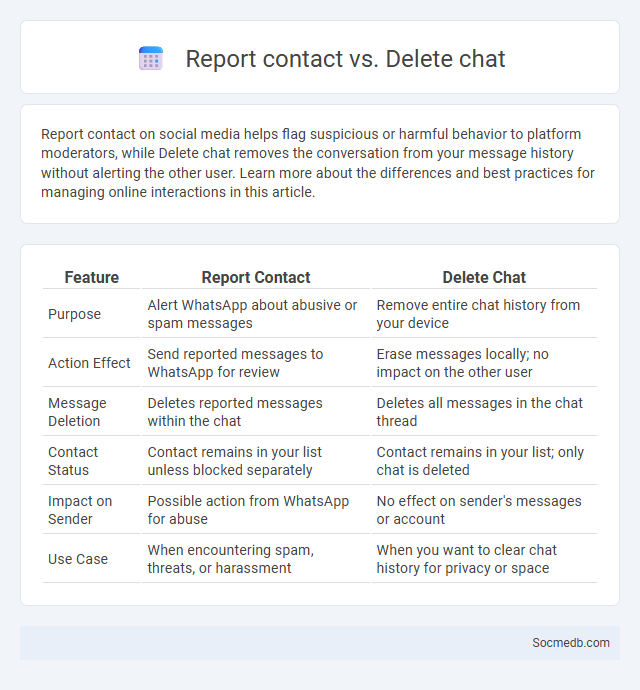
Photo illustration: Report contact vs Delete chat
Report contact on social media helps flag suspicious or harmful behavior to platform moderators, while Delete chat removes the conversation from your message history without alerting the other user. Learn more about the differences and best practices for managing online interactions in this article.
Table of Comparison
| Feature | Report Contact | Delete Chat |
|---|---|---|
| Purpose | Alert WhatsApp about abusive or spam messages | Remove entire chat history from your device |
| Action Effect | Send reported messages to WhatsApp for review | Erase messages locally; no impact on the other user |
| Message Deletion | Deletes reported messages within the chat | Deletes all messages in the chat thread |
| Contact Status | Contact remains in your list unless blocked separately | Contact remains in your list; only chat is deleted |
| Impact on Sender | Possible action from WhatsApp for abuse | No effect on sender's messages or account |
| Use Case | When encountering spam, threats, or harassment | When you want to clear chat history for privacy or space |
Understanding Report Contact: Definition and Purpose
Understanding Report Contact in social media refers to identifying and analyzing interactions between users and reported content or accounts. This process helps platforms ensure community guidelines are upheld by reviewing notifications and follow-ups related to reports. Your awareness of how Report Contact works can improve your online safety and trust in social networks.
What Happens When You Report a Contact?
When you report a contact on social media platforms such as Facebook, Instagram, or Twitter, the system initiates a review process that evaluates the reported content based on community standards and policies. The reported contact's profile, messages, or posts are analyzed using automated tools and human moderators to determine if any violations occurred, which may result in content removal, account warnings, temporary suspensions, or permanent bans. Users are often kept informed about the outcome of their reports, while platforms prioritize user safety and enforce measures to prevent harassment, misinformation, or abusive behavior.
How to Report a Contact: Step-by-Step Guide
To report a contact on social media, start by navigating to the user's profile or selecting the offending message. Locate the "Report" option usually found in the menu represented by three dots or a gear icon. Follow the prompts to specify the nature of the violation, such as harassment, spam, or inappropriate content, ensuring a clear and detailed description to assist the platform's moderation team.
Delete Chat vs Report Contact: Key Differences
Deleting a chat removes your conversation history with a contact from your device, ensuring your messages are no longer accessible to you, while reporting a contact notifies the platform about potential violations such as spam or harassment. You should delete chats to maintain privacy, but reporting contacts is crucial for addressing abusive behavior and protecting the community. Understanding these distinct actions helps you manage your social media experience effectively and stay safe online.
When Should You Delete a Chat?
Deleting a chat is essential when sensitive information, such as personal data or confidential business details, is exposed to unauthorized users. Regular chat deletion helps maintain privacy by eliminating stored conversation histories that could be exploited in case of device theft or hacking. Clearing chats also optimizes app performance by reducing data storage and ensuring smoother user experience.
Effects of Deleting a Chat on Your Data
Deleting a chat on social media platforms often removes the conversation from your view but may not erase all traces stored on servers or backup systems, impacting your data privacy and security. Some platforms retain deleted chats for a certain period due to policy or technical constraints, affecting long-term data control and compliance with regulations like GDPR. Understanding these effects is crucial for managing personal data, preventing unauthorized access, and ensuring effective communication privacy settings.
Pros and Cons of Reporting a Contact
Reporting a contact on social media can enhance online safety by flagging harmful behavior such as harassment or misinformation, contributing to a healthier digital environment. However, false or malicious reports may lead to unjust consequences for users, including account suspension or loss of reputation. Balancing the benefits of community policing with the risks of misuse is essential for maintaining trust and fairness on social platforms.
Privacy Implications: Reporting vs Deleting
When managing your social media content, understanding privacy implications of reporting versus deleting is crucial. Reporting content alerts the platform to potential violations, which may lead to review and removal affecting your data visibility, while deleting directly removes the content from your profile without third-party intervention. You should weigh the impact on your privacy and control over personal information when choosing between these options.
Frequently Asked Questions: Report Contact and Delete Chat
You can easily report inappropriate content or contacts on social media platforms by accessing the profile or message options and selecting the report feature to ensure your safety. To delete a chat, open the conversation, locate the delete or remove option, and confirm the action to permanently erase the message history. Managing your social media interactions allows you to maintain control over your privacy and digital environment effectively.
Which Action Is Right for You: Report Contact or Delete Chat?
Choosing the right action on social media depends on the situation: report contact if the person violates platform policies through harassment, spam, or inappropriate content to alert moderators and protect the community. Delete chat when conversations are no longer relevant, personal, or you want to remove clutter without escalating the issue. Understanding the difference between reporting harmful behavior and simply managing your message history enhances online safety and user experience.
 socmedb.com
socmedb.com